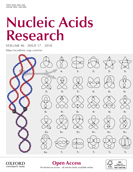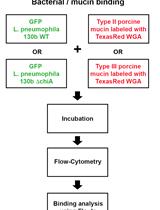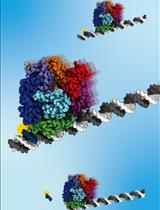- EN - English
- CN - 中文
Combining Gel Retardation and Footprinting to Determine Protein-DNA Interactions of Specific and/or Less Stable Complexes
结合凝胶阻滞和足印法测定特异性和/或不稳定复合物的蛋白质-DNA相互作用
发布: 2020年12月05日第10卷第23期 DOI: 10.21769/BioProtoc.3843 浏览次数: 3489
评审: Gustavo Caballero-FloresNaushaba HasinAnonymous reviewer(s)

相关实验方案

从大肠杆菌中大规模纯化III型毒素-抗毒素核糖蛋白复合物及其成分,用于生物物理学研究
Parthasarathy Manikandan [...] Mahavir Singh
2023年07月05日 2115 阅读
Abstract
DNA footprinting is a classic technique to investigate protein-DNA interactions. However, traditional footprinting protocols can be unsuccessful or difficult to interpret if the binding of the protein to the DNA is weak, the protein has a fast off-rate, or if several different protein-DNA complexes are formed. Our protocol differs from traditional footprinting protocols, because it provides a method to isolate the protein-DNA complex from a native gel after treatment with the footprinting agent, thus removing the bound DNA from the free DNA or other protein-DNA complexes. The DNA is then extracted from the isolated complex before electrophoresis on a sequencing gel to determine the footprinting pattern. This analysis provides a possible solution for those who have been unable to use traditional footprinting methods to determine protein-DNA contacts.
Keywords: DNase I footprinting (DNasel足印分析)Background
Nuclease/chemical footprinting is a classic method to probe protein-DNA interactions (Galas and Schmitz, 1978; Sasse-Dwight and Gralla, 1989; Hampshire et al., 2007). In this technique, the binding of a protein to a particular region of DNA inhibits (protection) or increases (enhancement) the ability of the nuclease or chemical to cleave the DNA. Consequently, if using 5’-end labeled DNA, a specific pattern of protection/enhancement will be revealed by incubation of the protein-DNA complex with the cleaving reagent and the subsequent electrophoresis of the DNA on a sequencing gel. However, in order to obtain a clear, interpretable pattern, the protein must bind the DNA relatively tightly during the cleavage process. If the protein(s) of interest binds to the DNA weakly and/or if the protein has a fast off-rate, traditional footprinting methods are likely to fail. Furthermore, sometimes multiple complexes can be formed with differing protein-DNA contacts. In this case, the footprint pattern will only reveal the full ensemble of interactions rather than those associated with a discrete complex.
Here, we have developed a straightforward method to treat protein-radiolabeled DNA complexes with DNase I or KMnO4 followed by isolation of the bound complex using an Electrophoretic Mobility Shift Assay (EMSA). In this assay, the DNA is incubated with the protein(s) of interest, and free DNA is separated from protein-bound DNA by electrophoresis on a native gel. This separation occurs because the protein-DNA complex migrates more slowly than the free DNA on the gel. The protein-DNA complex of interest is then extracted from the excised polyacrylamide gel slice, and the DNA is isolated and electrophoresed on a sequencing gel to determine the footprint. In many instances, this protocol allows users to obtain clear footprint patterns even when investigating less stable and/or weakly bound complexes. For DNase I reactions, the protection pattern with or without protein(s) indicates protein binding site(s) while the hypersensitivity site(s)/enhancement pattern represents DNA bending, kinking, and/or looping. For KMnO4 reactions, enhancement bands represent regions containing single-stranded thymine residues, such as within an open transcription bubble. However, the procedure could be adapted to other types of enzymatic or chemical reagents, which would yield different types of patterns.
In the lab, we have successfully used this protocol to obtain clear footprints of protein-DNA complexes for transcriptional activators in two different bacterial systems: Bordetella pertussis BvgA (Boulanger et al., 2015) and Vibrio cholerae VpsR (Hsieh et al., 2018 and 2020) in the presence and absence of RNA polymerase (RNAP). In the case of VpsR, we separated the protein-DNA complexes formed in the presence or absence of the small molecule cyclic-di-GMP (c-di-GMP) from the free DNA (Figure 1A, 1B) in order to obtain direct patterns of the complexes themselves (Figure 1C). In the case of phosphorylated response regulator BvgA (BvgA~P), while only one complex, the open complex (RPo), was formed by RNAP in the absence of ribonucleoside triphosphates (rNTPs) (Figure 2A, lanes 1 vs. 2), two complexes, both RPo and the initiating complex (RPi), were formed by RNAP in the presence of rNTPs (Figure 2A, lane 3). Consequently, we used this technique to separate RPi from the free DNA and from RPo, allowing us to visualize the DNase I footprint of each complex separately (Figure 2B, lanes 2 and 3). We also employed this method together with KMnO4 footprinting to determine the position of the transcription bubble within RPo formed by RNAP with non-phosphorylated BvgA (Figure 2A, lane 4) or within RPo formed by RNAP and BvgA~P (Figure 2A, lane 2). This yielded the KMnO4 footprints seen in Figure 2C, lanes 1 and 2, respectively. We were then able to compare these results to those obtained without the complex isolation step (Figure 2D, lanes 1 and 2), allowing us to determine how the stable complexes differed from the mixture of complexes that were formed in solution.
Figure 1. Example of EMSA/DNase I footprinting. Figure has been adapted and reprinted with permission from Hsieh et al., 2018. (A) and (B) EMSA gels showing complexes formed by the V. cholerae regulator VpsR bound to the promoter DNA for the V. cholerae gene vpsL (PvpsL) in the presence and absence of the small molecule c-di-GMP and in the absence (A) and presence (B) of RNA polymerase (RNAP), as indicated. The position of the free DNA is indicated by grey arrows while shifted complexes are represented by black arrows. Binding reactions in (A) contained 5 nM 32P-labeled nontemplate PvpsL harboring -97 to +103 relative to the transcription start site, 1 μg poly (dI-dC) as competitor, and increasing amounts of VpsR from 0 to 2 μM in the absence (lanes 1-5) and presence (lanes 6-10) of 50 μM c-di-GMP. Binding reactions in (B) contained 0.04 μM PvpsL, 0.14 μM reconstituted RNAP (σ:core ratio of 2.5:1), 1.4 μM VpsR, and 50 μM c-di-GMP, as indicated, and the reactions were competed with 500 ng heparin for 15 s. (C) Sequencing gels showing the DNase I products from isolated complexes. In these cases, reactions were incubated with 0.3 U of DNase I at 37 °C for 30 s before loading on the EMSA gel, the free DNA and complexes were excised and isolated, and after extraction, the DNA was electrophoresed on the gel. GA indicates G+A ladder. A schematic of the -10 element, -35 element, and the +1 position of PvpsL is shown to the right of the image. Protection pattern and hypersensitivity sites are indicated by black rectangular boxes and thin black arrows, respectively. Dashed red box represents the VpsR binding site. 
Figure 2. Example of EMSA/DNase I footprinting and of KMnO4 footprinting with and without isolation of protein-DNA complexes from EMSA gel. Figure has been adapted and reprinted with permission from Boulanger et al., 2015. (A) EMSA gel showing complexes formed by the B. pertussis response regulator BvgA either phosphorylated (BvgA~P) or non-phosphorylated (BvgA), the promoter for the B. pertussis gene fim3 (Pfim3), and RNAP. Binding reactions contained 0.05 pmol DNA, 5 pmol BvgA or BvgA~P, and 0.75 pmol reconstituted RNAP (σ:core ratio of 2.5:1). All samples were competed with 200 μg/ml heparin and as indicated, rNTPs (GTP, ATP, and CTP) were added. Free DNA is represented by a grey arrow while the open complex (RPO) is labeled with a black arrow and the initiating complex (RPI) is represented by a dashed black arrow. (B) Sequencing gels showing DNase I footprints at Pfim3 obtained from binding reactions with 0.36 U of DNase I and the subsequent EMSA isolation step. A schematic of the binding region as well as -35 , -10, and +1 is to the right of the image. Hypersensitive sites at -15 and -80, observed with RPi, but not with RPo, are indicated with the ‘*’. (C) and (D) Sequencing gels showing KMnO4 footprints in the region of position +1 of Pfim3 obtained by treating the binding reactions with 2.5 mM KMnO4 for 2.5 min at 37 °C and then either obtaining complexes from an EMSA gel and isolating the DNA before running the sequencing gel (C) or using the binding reaction products directly without the EMSA isolation step (D). Binding reactions contained 0.5 pmol DNA, 12 pmol BvgA or BvgA~P and 1.125 pmol reconstituted RNAP (σ:core ratio of 2.5:1). GA represents G+A ladder.
Materials and Reagents
Note: All reagents are stored at room temperature unless otherwise indicated.
UltraCruz® Autoradiography Tape (Santa Cruz Biotechnology, catalog number: sc-200214)
Clear plastic wrap, such as Saran Wrap or Glad Cling Wrap
Razor blade (Personna Gem, catalog number: 62-0179 or equivalent)
1.7 ml microtubes (sterile, RNase- and DNase-free) (Genesee Scientific, catalog number: 24-282S )
0.2 ml PCR tubes (Axygen, catalog number: PCR-02-C )
1.5 ml Pestle (Fisher Scientific, catalog number: 12-141-364 )
50 ml, 0.22 micron Millipore Steriflip filtration system (Sigma-Aldrich, catalog number: SCGP00525 )
Ultrafree MC Centrifugal Filters (Millipore, catalog number: UFC30HV00 )
8” x 10” Hyblot CL Autoradiography Film (Denville Scientific, catalog number: E3018 )
14” x 17” Hyblot CL Autoradiography Film (Denville Scientific, catalog number: E3031 )
TranScreen-HE (Kodak, catalog number: 881-1457 )
8” x 10” Film cassettes (Research Products International, catalog number: 420180 )
14” x 17” Film cassettes (Research Products International, catalog number: 421417 )
8” x 10” Film cassette security bag (Thomas Scientific, catalog number: E3753-1 )
14” x 17” Film cassette security bag (Thomas Scientific, catalog number: E3753-0 )
Purified proteins to be tested and stored at the appropriate temperature for the particular protein
Oligonucleotides that anneal to the 5’-end of the DNA regions (usually 20-30 basepairs (bp)) and are used in PCR to amplify the DNA region needed for footprinting, dissolved in ddH2O at 50 pmol/μl and stored at -20 °C (We recommend using PCR to generate a DNA fragment of 200 to 300 bp). We have obtained oligonucleotides from Integrated DNA Technologies. However, oligonucleotides can be purchased from many sources.
Genomic DNA or plasmid DNA containing the protein-binding DNA region that can be used as a template for PCR amplification, dissolved in ddH2O or TE (see below) at 100 ng/ml and stored at 4 °C (genomic DNA) or at -20 °C (plasmid DNA)
[γ-32P]-ATP (3,000 Ci/mmol, 10 mCi/ml, 250 μCi) (PerkinElmer, catalog number: BLU002A; stored at -20 °C)
Optikinase (10 U/μl) and 10x Optikinase buffer (USB Affymetrix, catalog number: 78334Y ; stored at -20 °C)
Pfu Turbo polymerase (2.5 U/μl) and 10x Pfu buffer (Agilent Technologies, catalog number: 600252 ; stored at -20 °C)
dNTP mix (New England Biolabs, catalog number: N0447, 10 mM; stored at -20 °C)
DNase I (2 U/μl) and 10x DNase I buffer (Life Technologies, catalog number: AM2222 ; stored at -2 °C)
Heparin (Sigma-Aldrich, catalog number: H3149 , 500 μg/ml dissolved in ddH2O; stored at -20 °C)
Poly(deoxyinosinic-deoxycytidylic) (Poly(dI-dC)) acid sodium salt (Sigma-Aldrich, catalog number: P4929 , 1 mg/ml dissolved in ddH2O; stored at -20 °C)
Urea Ultrapure (Invitrogen, catalog number: 15505-050 )
Petroleum jelly
Large binder clips
40% 19:1 Acrylamide:bis solution (Bio-Rad Laboratories, catalog number: 1610144 ; stored at 4 °C)
40% 37.5:1 Acrylamide:bis solution (Bio-Rad Laboratories, catalog number: 1610148 ; stored at 4 °C)
Tetramethylethylenediamine (TEMED) (Bio-Rad Laboratories, catalog number: 1610800 ; stored at 4 °C)
TE-saturated Phenol, pH 8.0 (Sigma-Aldrich, catalog number: 77607 ; stored at 4 °C)
Phenol:chloroform:isoamyl alcohol (25:24:1 v/v, pH 7.9) (Life Technologies, catalog number: AM9732 ; stored at 4 °C)
190 proof ethanol (Warner-Graham Company; stored at -20 °C)
Drawn-out plastic pipet (Fisher Scientific, catalog number: 13-711-27 )
GlycoBlueTM Coprecipitant (Invitrogen, catalog number: AM9515 ; stored at -20 °C)
10x TBE Buffer (Quality Biological, catalog number: 351-001-131 )
50x TAE Buffer (Quality Biological, catalog number: 351-008-131 )
TE pH 8.0 (Quality Biological, catalog number: 351-011-131 )
0.5 M EDTA, pH 8.0 (Quality Biological, catalog number: 351-027-101 )
Formamide (Sigma-Aldrich, catalog number: 47670 )
1-Butanol (Fisher Scientific, catalog number: A399-500 )
3 M Sodium Acetate (Sigma-Aldrich, catalog number: 71196 )
Dry ice
6x Dye Loading solution for native gel (Fermentas, catalog number: R0611 )
Xylene cyanol (XC) dye (Sigma-Aldrich, catalog number: X4126 )
Bromophenol blue (BPB) dye (Sigma-Aldrich, catalog number: B0126 )
AG® 501-X8(D) mixed bed resin (Bio-Rad Laboratories, catalog number: 1426425 )
Salmon sperm DNA (Sigma-Aldrich, catalog number: D1626 ; 10 mg/ml, 5 mg/ml, and 1 mg/ml dissolved in ddH2O; stored at -20 °C)
ddH2O
APS (Bio-Rad Laboratories, catalog number: 1610700 )
Ammonium acetate (Sigma-Aldrich, catalog number: A7330 )
Calcium chloride dihydrate (Sigma-Aldrich, catalog number: C3306 )
KMnO4 (Sigma-Aldrich, catalog number: 223468 )
Magnesium acetate tetrahydrate (Sigma-Aldrich, catalog number: M5661 )
Formic acid stock (88%) (Sigma-Aldrich, catalog number: 399388 ). 4% diluted in ddH2O (see Recipes)
50 mM KMnO4 (Potassium permanganate) (see Recipes)
10% Ammonium persulfate (APS) (see Recipes)
10 M Ammonium acetate (see Recipes)
1 M Magnesium acetate (see Recipes)
20% SDS (Quality Biological, catalog number: 351-066-721 ); 1% SDS diluted in ddH2O (see Recipes)
2 mM CaCl2 (Calcium chloride) (see Recipes)
Piperidine stock (10 M) (Sigma-Aldrich, catalog number: 104094 ); 2 M and 100 mM diluted in ddH2O (see Recipes)
Formamide loading dye; stored at -20 °C (see Recipes)
2-mercaptoethanol stock (14.3 M) (Sigma-Aldrich, catalog number: M3148 ). 1 M diluted in ddH2O (see Recipes)
70% ethanol (see Recipes; stored at -20 °C)
Diffusion buffer (see Recipes)
Equipment
Suitable space for working with 32P radioactivity
Geiger counter to monitor radioactivity and contamination
Plexiglass shield to protect user from radioactivity
Plexiglass box for 32P waste
150 ml, 0.22 micron filter apparatus (Nalgene, catalog number: 125-0020 or equivalent)
PCR Machine
Vortex (such as Vortex Genie 2, Scientific Industries)
Heating block that that can warm up to 95 °C
Vertical gel box - medium size (~7”W x ~9”H) (such as Cole-Parker Vertical Single Adjustable Slab Gel System, catalog number: EW-28570-00 or HoeferTM Air-cooled Vertical Electrophoresis Unit, catalog number: SE400 )
Vertical gel box- large size (~14”W x ~17”H) (such as LABRepCo Model S2 Sequencing gel Electrophoresis Apparatus, catalog number: 21105036 or BTLab Systems Nucleic Acid Sequencing Electrophoresis cell (330 x 420 mm), catalog number: BT210 )
Elutrap electroelution system (GE Healthcare, catalog number: 10447711 )
Power supply box for electrophoresis (Bio-Rad Laboratories)
Small Microcentrifuge, such as Benchmark MyFuge Mini that spins at 6,000 rpm/2,000 x g
Benchtop Microcentrifuge, such as Eppendorf Centrifuge 5425 that can spin at ≥ 14,000 x g (Eppendorf, catalog number: 5405000646 )
Speed Vacuum (we use Thermo Electron Corp. Savant DNA 120 SpeedVac System, whose speed is 1600 rpm; Thermo Fisher Scientific, catalog number: 13442549 )
Scintillation Counter
Film Developer (or phosphoimager)
Densitometer to scan autoradiographs [we use a GS-800 Calibrated Imaging Densitometer from Bio-Rad Laboratories, catalog number: 170-7983 (discontinued); new model is GS-900, catalog number: 170-7989 ]
Glass plates with spacers and combs to fit medium sized gel apparatus (Gel Company; we suggest a gel thickness of 1 mm)
Glass plates with spacers and combs to fit large sized gel apparatus (Gel Company; we suggest a gel thickness of 1 mm)
Software
Software to operate densitometer (We use Quantity One from Bio-Rad Laboratories, catalog number: 1709601)
Procedure
文章信息
版权信息
© 2020 The Authors; exclusive licensee Bio-protocol LLC.
如何引用
Hsieh, M., Boulanger, A., Knipling, L. G. and Hinton, D. M. (2020). Combining Gel Retardation and Footprinting to Determine Protein-DNA Interactions of Specific and/or Less Stable Complexes. Bio-protocol 10(23): e3843. DOI: 10.21769/BioProtoc.3843.
分类
微生物学 > 微生物生物化学 > DNA
微生物学 > 微生物生物化学 > 蛋白质 > 相互作用
生物化学 > 蛋白质 > 相互作用 > 蛋白质-DNA相互作用
您对这篇实验方法有问题吗?
在此处发布您的问题,我们将邀请本文作者来回答。同时,我们会将您的问题发布到Bio-protocol Exchange,以便寻求社区成员的帮助。
Share
Bluesky
X
Copy link











